Bernard Palissy (1510-1589), a religious man and something of a polymath,
flourished in France during the troubled spread of Protestantism. A Renaissance
man, writer, philosopher, naturalist and artist, living in the village of Saintes,
Bordeaux in the late 1530s. Primarily working as a stained glass maker, portrait
painter and land surveyor, he turned to clay when his 'artistic' work dried up.
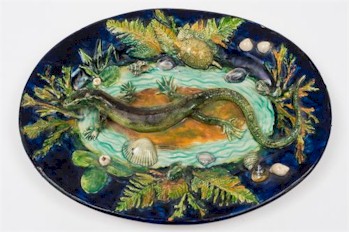
A wider French Palissy Ware dish signed and dated Boch 1892
(FS29/573).
The transition was far from easy and it took many years of trial and error and bouts
of poverty before in 1555 he was successful. At one critical point, Palissy claims
to have fuelled his kiln with his garden fence, the flooring in his house and his
furniture!
Subsequently, Palissy became renowned for making playful rustic wares inspired by
the flora and fauna around him. Often having the air of a garden pond or marsh about
them, they were exquisitely modelled with glossy wet looking lizards, snakes, fish
and frogs, all accurately rendered as they were more often than not moulded from
the carcasses of little beasties.
At the time, France was in the grip of the Reformation and Bernard Palissy, a Huguenot
who would not renounce his faith, was imprisoned on a number of occasions, finally
succumbing to malnourishment in the Bastille in 1589. His skills and techniques
died with him as he was understandably reluctant to share skills that were hard
won during his early years.
However, the 'concept' didn't completely disappear. Several French
faience
manufacturers did produce tureens in the form of birds and boars heads and many
produced tromp l'oeil fruits and vegetables during the 18th century though none
achieved even passable realism.
The rebirth of
Palissy Ware
occurred in Tours with the Avisseau family of potters in the mid-19th century;
led by Charles Jean Avisseau history seemed to repeat itself. He, too,
had firing problems and unacceptable losses in the kiln – worse still his florid
work didn't travel or handle well and often ended up in pieces in the hands of new
owners. Unlike Palissy, Avisseau actually sculpted his animals from scratch rather
than moulding from specimens.
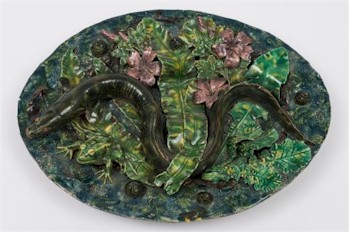
A Landais family Tours School Palissy Ware dish
(FS29/572).
Another significant proponent in Tours was Joseph Landais, Avisseau's brother-in-law,
with whom he had an acrimonious three month partnership and then feuded with for
the rest of his life!
As the century progressed, the Tours School supported many others such
as Leon Brard, the Chauvigné family, George Delperier,
Louis Tinier and Octave Deniau to name a few.
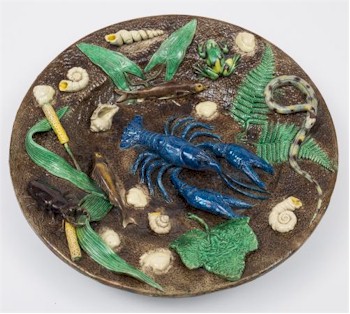
A Paris school Palissy Ware dish by François Maurice
(FS29/571).
Paris became a rival centre when Victor Barbizet and his son Achille Barbizet
started a workshop undercutting Tours by using 'mass production' techniques. They
were able to manufacture prolifically by pressing clay into premade moulds and finishing
by hand before assembly.
Contemporaries in Paris include Georges Pull who made copies of Bernard
Palissy's work, often passed off as the real thing on the resale market, despite
being signed. Others worthy of mention include François Maurice and Thomas
Victor Sergent and countless others elsewhere across France.
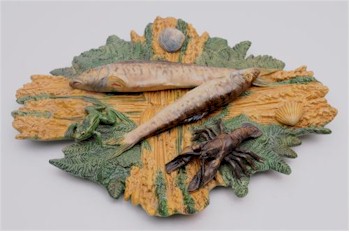
A Palissy Ware plaque by Alfred Renoleau, circa 1890.
Palissy Ware came to wider popularity when the Victoria & Albert Museum
purchased several pieces at the Paris Exposition in 1855 and the trend
spread further with a contemporaneous, but stylistically different centre of production
around the town of Caldas da Rainha in Portugal. Also there are very obvious links
with the
majolica wares
produced by Minton and George Jones, who looked to be just a teensy
bit influenced by what was happening over the Channel.
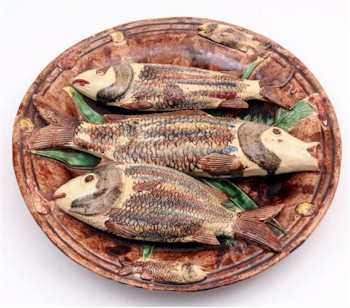
An example of Portuguese Palissy Ware by Manuel Mafra.
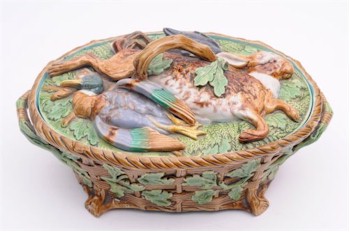
A George Jones majolica dish and cover showing the influence of Palissy.
- Bearnes Hampton & Littlewood
- Fine Porcelain
- Bernard Palissy
- Charles Jean Avisseau
- Joseph Landais
- Leon Brard
- Chauvigné family
- George Delperier
- Louis Tinier
- Octave Deniau
- Victor Barbizet
- Achille Barbizet
- Georges Pull
- François Maurice
- Thomas Victor Sergent
- Minton
- George Jones
French Palissy Ware - Rustic Pottery inspired by the Natural World was written on
Friday, 4th December 2015.










